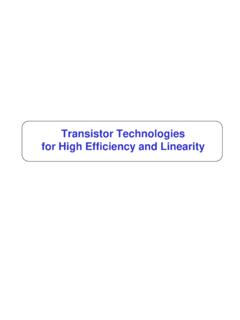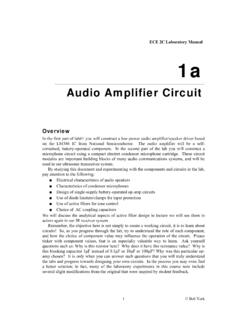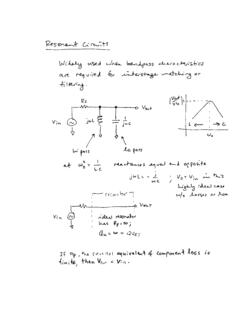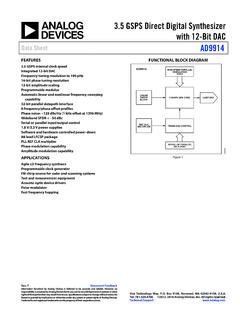Transcription of Phase Locked Loop Circuits
1 Phase Locked Loop Circuits Reading: General PLL Description: T. H. Lee, Chap. 15. Gray and Meyer, Clock generation: B. Razavi, Design of Analog CMOS Integrated Circuits , Chap. 15, McGraw-Hill, 2001. 1. Definition. A PLL is a feedback system that includes a VCO, Phase detector, and low pass filter within its loop. Its purpose is to force the VCO to replicate and track the frequency and Phase at the input when in lock. The PLL is a control system allowing one oscillator to track with another. It is possible to have a Phase offset between input and output, but when Locked , the frequencies must exactly track.
2 ()(.)()(ttconstttinoutinout = + = The PLL output can be taken from either Vcont, the filtered (almost DC) VCO control voltage, or from the output of the VCO depending on the application. The former provides a baseband output that tracks the Phase variation at the input. The VCO output can be used as a local oscillator or to generate a clock signal for a digital system. Either Phase or frequency can be used as the input or output variables. Of course, Phase and frequency are interrelated by: PhasedetectorLoopfilterVCO in(t) in(t) out(t) out(t)ve(t)VcontPhasedetectorLoopfilterV CO in(t) in(t) out(t) out(t)ve(t)Vcont + = = tdtttdtdt0')'()0()()( Applications: There are many applications for the PLL, but we will study: a.)
3 Clock generation b. frequency synthesizer c. Clock recovery in a serial data link UCSB/ECE Department Prof S. Long 4/27/05 1 You should note that there will be different design criteria for each case, but you can still use the same basic loop topology and analysis methods. 2. Phase detector: compares the Phase at each input and generates an error signal, ve(t), proportional to the Phase difference between the two inputs. KD is the gain of the Phase detector (V/rad). )]()([)(ttKtvinoutDe = As one familiar circuit example, an analog multiplier or mixer can be used as a Phase detector.
4 Recall that the mixer takes the product of two inputs. ve(t) = A(t)B(t). If, A(t) = A cos( 0t + A) B(t) = B cos( 0t + B) Then, A(t)B(t) = (AB/2)[ cos(2 0t + A + B) + cos( A - B)] Since the two inputs are at the same frequency when the loop is Locked , we have one output at twice the input frequency and an output proportional to the cosine of the Phase difference. The doubled frequency component must be removed by the lowpass loop filter. Any Phase difference then shows up as the control voltage to the VCO, a DC or slowly varying AC signal after filtering.
5 The averaged transfer characteristic of such a Phase detector is shown below. Note that in many implementations, the characteristic may be shifted up in voltage (single supply/single ended). /2 KD /2-KD /2Ve /2 KD /2-KD /2Ve If the Phase difference is /2, then the average or integrated output from the XOR-type Phase detector will be zero (or VDD/2 for single supply, digital XOR). The slope of the characteristic in either case is KD. 3. VCO. In PLL applications, the VCO is treated as a linear, time-invariant system.
6 Excess Phase of the VCO is the system output. UCSB/ECE Department Prof S. Long 4/27/05 2 = tcontOoutdtVK' The VCO oscillates at an angular frequency , out. Its frequency is set to a nominal 0 when the control voltage is zero. frequency is assumed to be linearly proportional to the control voltage with a gain coefficient KO or KVCO (rad/s/v). contOoutVK+ = 0 Thus, to obtain an arbitrary output frequency (within the VCO tuning range, of course), a finite Vcont is required. Let s define out in = . (Figure from B.)
7 Razavi, Ch. 15, op. cit.) In the figure above, the two inputs to the Phase detector are depicted as square waves. The XOR function produces an output pulse whenever there is a Phase misalignment. Suppose that an output frequency 1 is needed. From the upper right figure, we see that a control voltage V1 will be necessary to produce this output frequency . The Phase detector can produce this V1 only by maintaining a Phase offset 0 at its input. In order to minimize the required Phase offset or error, the PLL loop gain, KD KO, should be maximized, since ODDKKKV0110 == Thus, a high loop gain is beneficial for reducing Phase errors.
8 4. PLL dynamic response: To see how the PLL works, suppose that we introduce a Phase step at the input at t = t1. )(1101ttutin ++= UCSB/ECE Department Prof S. Long 4/27/05 3 (Figure from B. Razavi, Ch. 15, op. cit.) Since we have a step in Phase , it is clear that the initial and final frequencies must be identical: 1. But, a temporary change in frequency is necessary to shift the Phase by 1. The area under out gives the additional Phase because Vcont is proportional to frequency . ==11)(1ttcontOoutdttVKdt After settling, all parameters are as before since the initial and final frequencies are the same.
9 This shows that Vcont(t) [shown as VLPF (t) in the figure above] can be used to monitor the dynamic Phase response of the PLL. Now, let s investigate the behavior during a frequency step: +=12 The frequency step will cause the Phase difference to grow with time since a frequency step is a Phase ramp. This in turn causes the control voltage, Vcont, to increase, moving the VCO frequency up to catch up with the input reference signal. In this case, we have a permanent change in out since a higher Vcont is required to sustain a higher out.
10 UCSB/ECE Department Prof S. Long 4/27/05 4 (Figure from B. Razavi, Ch. 15, op. cit.) If the frequency step is too large, the PLL will lose lock. 5. Lock Range. Range of input signal frequencies over which the loop remains Locked once it has captured the input signal. This can be limited either by the Phase detector or the VCO frequency range. a. If limited by Phase detector: /2 KD /2-KD /2Ve /2 KD /2-KD /2Ve 0 < < is the active range where lock can be maintained. For the Phase detector type shown (Gilbert multiplier or mixer), the voltage vs.













